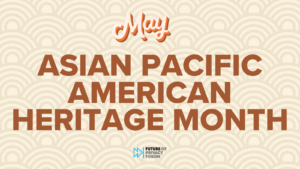During Asian Pacific American Heritage Month, a look at how better data can benefit AANHPI individuals and communities
May is Asian Pacific American Heritage Month (APAHM), a celebration of Asian Americans, Native Hawaiians, and Pacific Islanders (AANHPIs) in the United States. However, there are challenges that this rapidly growing racial group experiences, specifically regarding the collection and use of AANHPI data. In honor of APAHM, we are highlighting the gaps in research and data collection around AANHPI populations that have led to, among other things, a loss of political representation and valuable resources, as well as concrete steps that can be taken today and into the future to ensure more equitable outcomes.
Individuals from AANHPI communities hail from more than 40 countries and include even more ethnic identities. This term captures a collection of people with diverse languages, histories, ethnicities, idiosyncrasies, and cultures. It also represents the fastest-growing racial and ethnic group within the U.S. However, errors in data collection and management mean that individuals from these communities are politically under-represented and economically and socially under-resourced. An analysis of data from the 2020 U.S. Census revealed that 68% of U.S. counties undercounted their Asian populations, and 55% undercounted the number of Native Hawaiian and Pacific Islander (NHPI) individuals.
Data plays a critical role in policymaking by providing empirical evidence and offering insights that inform decision-making processes helping to ensure that policymaker choices are grounded in facts. The U.S. decennial census provides a wellspring of data from across the country every ten years. This data determines the number of seats each state receives in the U.S. House of Representatives and is used for redistricting at various levels of government, including state legislatures, county commissions, and city councils. Census data is also instrumental in allocating federal funding to communities for community and social services. More generally, census data provides valuable insight into the characteristics and needs of a community and can reveal disparities across different communities. Policymakers and government leaders can tailor policies and programs to their communities by using census data like race, income levels, education levels, and housing conditions; researchers and analysts may use that same data to recommend interventions to address economic, healthcare, housing, and educational needs.
In addition to contributing to a lack of resource and political allocation, data quality issues related to AANHPI individuals may also perpetuate common themes of racism and stereotyping. For example, aggregated data for AANHPIs hides the health and economic struggles of some Asian subgroups, subjecting them to false beliefs that all AANHPIs are successful and well-adapted, when in reality, their struggles are rendered invisible.
When it comes to ensuring proper representation, recognizing the problem is only the first step. The following recommendations are necessary to start the process of better accounting for and serving the diverse needs of all individuals in the U.S., including individuals from AANHPI communities:
1. Create pathways for privacy-protective data disaggregation: It is crucial to recognize the heterogeneity within the AANHPI population and avoid treating it as a monolithic group in data analysis and policy formulation. Disaggregated data breaks down population-level information by detailed sub-categories and can reveal details about sub-groups that are experiencing deprivations and inequalities that are not fully reflected in aggregated data. Civil rights groups have consistently advocated for disaggregated data to better understand the needs of the AANHPI community. While there are privacy risks with disaggregation that need to be recognized and accounted for, disaggregated data for the AANHPI population can also provide detailed information on specific ethnic subgroups within the population allowing for an understanding of disparities and tailoring of policies to address unique needs. For example, disaggregated data for AANHPI populations reveals that while Indian Americans have an average poverty rate of 6%, Mongolian Americans and Burmese Americans have a poverty rate of 25%. Disaggregated data also reveals that while 75% of Taiwanese Americans hold a bachelor’s degree, only 14% of Laotian Americans do.
2. Avoid stereotyping and generalization: Stereotypes and generalizations about AANHPIs can influence how data is collected, analyzed, and interpreted. Researchers conducting studies on certain populations may overlook conducting the same studies on AANHPI populations due to harmful assumptions, including the model minority myth. For instance, a 2017 report on perinatal morbidity and mortality of AANHPI women found that despite a higher socioeconomic status, AANHPI women “experience higher rates of maternal morbidity and mortality.” Additional studies on perinatal experiences of women during COVID-19 pointed out that AANHPI women had been “largely underrepresented in study samples” and emphasized a need for targeted research for culturally responsive care for perinatal women. Another similar report stated that data on AANHPI women was “limited due to scarcity of existing studies.”
3. Knockdown language barriers: AANHPIs, particularly those with limited-English proficiency or who are recent immigrants, may face barriers to accessing and participating in data collection processes. Language barriers and cultural differences can hinder accurate data collection and representation in datasets, leading to underreporting of important data. The methods used to collect data, such as surveys, should be available in multiple languages, especially in the language spoken by the communities it is targeting. In 2020, the U.S. Census made strides in this area by ensuring respondents could respond to questions directly in 12 different languages, up from six in 2010. In addition, surveys should also be developed and reviewed by trusted community members to ensure translations are accurate and understandable.
4. Ensure accurate reporting: The COVID-19 pandemic and the rise in anti-Asian hate created a climate of fear and distrust towards the AANHPI community that resulted in horrific violence and discrimination. Each year the FBI releases its report on hate crimes statistics, mandated under the Hate Crimes Statistics Act of 1990. However, reporting by law enforcement to the FBI on this information is voluntary, meaning it is likely very under-representative of what is happening. Civil rights organizations have argued against the “voluntary” nature of reporting and argue that the resulting data is likely unreliable and incomplete. FBI Director Christopher Wray stated to Congress that, “Some jurisdictions fail to report hate crime statistics, while others claim there are no hate crimes in their community.” In contrast, AAPI Data released a report that found that 10% of AANHPI adults experienced “hate crimes and hate incidents in 2021,” significantly higher than the national average. Only about 30% of AANHPI individuals report feeling comfortable reporting a hate crime to law enforcement and have cited fear of retaliation, lack of confidence that justice will be served, and concerns about undue attention to their families as their reasoning.
5. Where possible, adjust for bias and underrepresentation in data sets: If the aforementioned barriers to participation in data collection are not addressed, the result will be continued underrepresentation in datasets. As companies, organizations, and government agencies further deploy algorithmic tools for a wider variety of tasks and programs, this under-representation in the data those tools are trained on may lead to even more significant impacts on individuals from impacted communities. Organizations developing tools need to be aware of potential data quality issues and appropriately and ethically adjust for bias and underrepresentation when possible to ensure that decisions made by these tools do not exacerbate the existing challenges for individuals and communities.
Addressing underrepresentation in data requires improved data collection methodologies that acknowledge the diversity within the AANHPI population, allocate resources to support comprehensive data collection efforts, and promote disaggregated reporting. Policymakers and researchers should work collaboratively with AANHPI communities to ensure accurate and representative data collection, analysis, and interpretation to inform policies that address the unique needs and challenges faced by different AANHPI groups.


